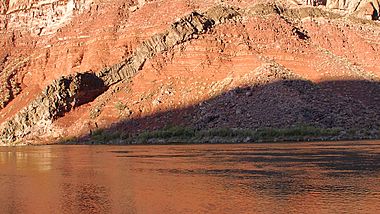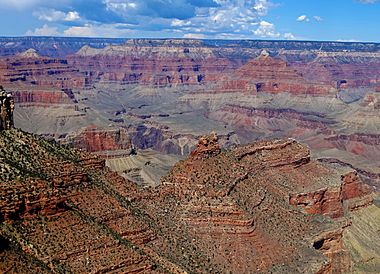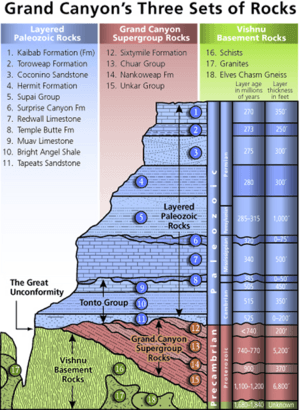Hakatai Shale facts for kids
Quick facts for kids Hakatai ShaleStratigraphic range: Meso-Proterozoic, 1,200±50 Ma? |
|
|---|---|

Three approximate equal-thickness formations outcropping below Isis Temple-prominence at north perimeter, Granite Gorge
(Unkar Group)-Shinumo Quartzite (vertical cliffs), upon basalt sills, upon orange-red Hakatai Shale, upon Bass Formation. Dk blackish canyons are the Granite Gorge Vishnu Basement Rocks. |
|
| Type | Geological formation |
| Unit of | Unkar Group (5 units) |
| Underlies | Shinumo Quartzite-(unit 3) |
| Overlies | Bass Formation-(unit 1) |
| Thickness | 985 feet (300 m) approximate maximum |
| Lithology | |
| Primary | shale |
| Other | siltstone, sandy siltstone, and sandstone (subarkose, arkose and quartz arenite) |
| Location | |
| Region | Arizona, Grand Canyon Isis Temple region, southwest Bright Angel Canyon, at north side, Granite Gorge, and along Colorado River, also, numerous side canyons to Granite Gorge / Colorado River |
| Country | United States (Southwest United States) |
| Type section | |
| Named for | Hakatai Canyon |
| Named by | Noble (1914) |
The Hakatai Shale is a very old rock layer found in the Grand Canyon, Arizona. It formed during the Mesoproterozoic Era, which was about 1.2 billion years ago. This rock layer is famous for its amazing colors, which range from purple to red to bright orange. These colors come from iron minerals inside the rock that have rusted over time.
The Hakatai Shale is made up of different parts. The lower and middle parts are mostly bright-red, broken mudstone and shale. The upper part is purple and red sandstone. Its thickness changes, from about 450 feet (137 meters) to 985 feet (300 meters). The Hakatai Shale and other rocks in the Unkar Group usually tilt northeast. Dark, thick layers of basalt (a type of volcanic rock) called sills and dikes cut through the Hakatai Shale.
The bright orange-red slopes of the Hakatai Shale stand out against the gray rocks of the Bass Formation. It also looks very different from the tall cliffs made by the Shinumo Quartzite. If you look from the South Rim of the Grand Canyon, you can see the orange-red Hakatai Shale below famous landmarks like Isis Temple and Cheops Pyramid.
The Hakatai Shale is part of a larger group of sedimentary rocks called the Unkar Group. This group is very thick, about 5,200 to 7,200 feet (1,600 to 2,200 meters) in total. It includes, from bottom to top: the Bass Formation, Hakatai Shale, Shinumo Quartzite, Dox Formation, and Cardenas Basalt. Above the Unkar Group are other rock layers like the Nankoweap Formation, Chuar Group, and Sixtymile Formation. All these layers are part of the Grand Canyon Supergroup. This supergroup sits on top of even older, deeply eroded rocks called the Vishnu Basement Rocks.
Contents
What is the Hakatai Shale Made Of?
The Hakatai Shale is usually divided into three main parts. From bottom to top, these are the Hance Rapids (lower), Cheops Pyramid (middle), and Stone Creek (upper) members. The total thickness of the Hakatai Shale varies. It is about 440 feet (135 meters) thick at Hance Rapids and nearly 985 feet (300 meters) thick in Hakatai Canyon.
Hance Rapids Member: The Lower Layer
The Hance Rapids member is the lowest part. It is made of purple to reddish-purple mudstone. It also has layers of sandy siltstone and some thin layers of sandstone. The rocks in this lower part gradually change into the finer-grained middle part.
Cheops Pyramid Member: The Colorful Middle Layer
The Cheops Pyramid member is the middle part. It consists of mudstone, siltstone, and some sandy siltstone. This layer has a striking reddish-orange color. You might also see round, non-red spots within these red rocks. These spots have a dark-gray or greenish-gray center.
Stone Creek Member: The Upper Layer
The Stone Creek member is the top part of the Hakatai Shale. It is made of pale purple or lavender sandstone. This sandstone is fine to coarse-grained and often shows cross-bedding, which means the layers are tilted.
Volcanic Rocks in the Hakatai Shale
Volcanic rocks called sills and dikes cut through all the rocks of the Unkar Group, except for the Cardenas Basalt. Sills are flat layers of volcanic rock that squeeze between existing rock layers. Dikes are vertical layers of volcanic rock that cut across existing layers. Sills are found only in the Bass Formation and Hakatai Shale. Dikes cut through the Hakatai Shale, Shinumo Quartzite, and Dox Formation. Near these volcanic sills, the Hakatai Shale has changed into a harder rock called hornfels.
How Do the Hakatai Shale Layers Connect?
The way rock layers meet is called a "contact." The Hakatai Shale has different types of contacts with the layers above and below it.
Contact with the Bass Formation
In the eastern Grand Canyon, the Hakatai Shale gradually blends into the Bass Formation below it. This means the change from one rock type to the other happens slowly over a few feet. For example, in Red Canyon, you can see layers of Bass Formation limestone mixed with coarse rocks from the Hakatai Shale. In other areas, the contact is sharp but still shows that the layers were laid down one after another without a big break.
Contact with the Shinumo Quartzite
The contact between the Hakatai Shale and the Shinumo Quartzite above it is a clear break called a disconformity. This means there was a period when erosion happened, or no new rock layers were formed. This contact is sharp and sometimes cuts off tilted layers or channels in the Hakatai Shale. On top of this eroded surface, you might find a layer of conglomerate (rock made of pebbles and larger pieces). This conglomerate contains pieces of quartzite that are not found anywhere else in the Grand Canyon. Scientists believe this break represents about 75 million years of missing time.
Contact with the Tapeats Sandstone
The contact between the Hakatai Shale (and the rest of the Unkar Group) and the Tapeats Sandstone is a very important type of break called an angular unconformity. This is part of what geologists call the Great Unconformity. This means the older Unkar Group rocks were tilted and eroded before the Tapeats Sandstone was laid down. The erosion left tall hills of harder rocks like the Cardenas Basalt and Shinumo Quartzite. These ancient hills are now buried by the Tapeats Sandstone. The Hakatai Shale forms a flatter surface between these buried hills.
What Fossils Are Found in the Hakatai Shale?
Scientists have found Stromatolites in the Hakatai Shale in Rodgers Canyon. Stromatolites are layered structures created by tiny ancient organisms, similar to algae. They are found where the Hakatai Shale meets the Bass Formation. Here, layers of stromatolitic carbonate (limestone) are mixed with coarse Hakatai Shale deposits. The base of these deposits contains small, rounded algal mounds built on sandstone and conglomerate pieces. Also, the dark centers of the colored spots in the Cheops Pyramid member might be from ancient organic material, possibly stromatolites.
Some older reports claimed to find other types of fossils, like animal trails, in the Hakatai Shale. However, these have since been shown to be non-living marks in the rock, not actual fossils.
How Did the Hakatai Shale Form?
Scientists study the rocks to understand the environment where they formed.
Hance Rapids Member Environment
The Hance Rapids (lower) member likely formed in shallow, calm waters. The change from the Bass Formation to this lower member probably means that the ocean was getting shallower.
Cheops Pyramid Member Environment
The Cheops Pyramid (middle) member probably formed in a shallow ocean near the shore. It could also have formed in coastal mudflats or deltas. The greenish-gray spots in these rocks are similar to spots found in other non-marine (not ocean) environments.
Stone Creek Member Environment
The Stone Creek (upper) member likely formed in a marine delta, which is where a river meets the ocean and deposits sediment.
How Old is the Hakatai Shale?
The Hakatai Shale is very old, dating back between 1,253 and 1,104 million years ago. We know this because it is younger than a layer of volcanic ash in the Bass Formation below it, which is 1,253 million years old. Also, studies of minerals from the Dox Formation above it show that the Hakatai Shale is younger than 1,140 million years. The Dox Formation itself is older than the Cardenas Basalt, which is 1,104 million years old.
Isis Temple-Cheops Pyramid Horst
Isis Temple-Cheops Pyramid is a small horst, which is a block of Earth's crust that has been lifted up between two faults. It is located near the center of the Grand Canyon. The Bright Angel Fault borders it on the east, and Granite Gorge borders it on the south. The Bright Angel Fault continues south across Granite Gorge and up the Bright Angel Trail. The north side of Isis Temple-Cheops Pyramid is bordered by the Grandview Fault.




